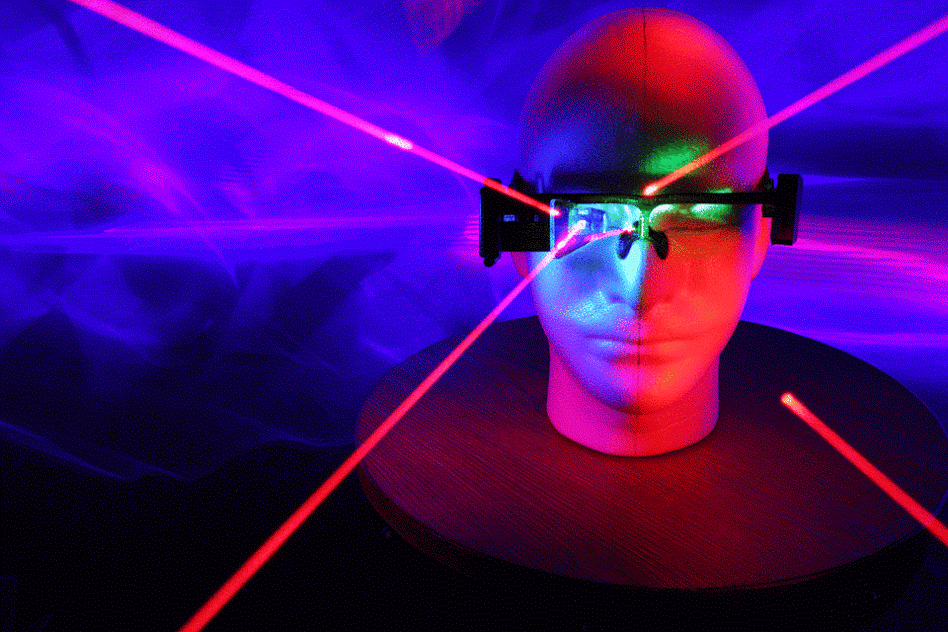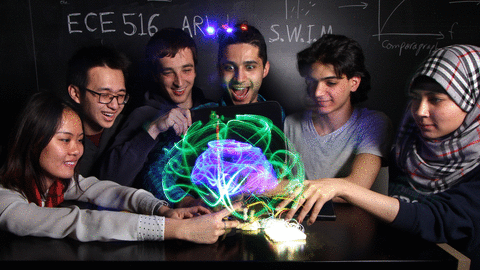ECE516: Intelligent Image Processing
Labs and authentic direct mentorship
Open your eyes to future possibilities:
 (photos of metaveillance flux from EyeTap Instructable)
(photos of metaveillance flux from EyeTap Instructable)
The most important part of this course is the labs which offer authentic
direct mentorship with a high degree of involvement from the professor and
other leading experts in imaging,
sensing, meta-sensing, human machine learning, XR (eXtended Reality) and
Mersivity.
Our goal for the undergraduates is to help you get into grad school at
MIT (Prof. Mann's alma mater) or Stanford, or to build the skills you need
to found a great startup or be the world's leader in your chosen field,
and for graduate students, finding a great thesis topic.
Lab topics (learn directly from the professor who invented many of these technologies and concepts):
- Fourier transform, wavelet transform, and chirplet transform;
- Machine learning for
computer vision: Radar Vision and LEM neural network (world's first
transform with machine learning built-in);
- AI for humans = Humanistic Intelligence (abbreviated H.I. or H. Int.)... link
- Wearable AI (Wearable AI = H. Int., link)
- VR (Virtual Reality), AR (Augmented Reality), and
XR (eXtended Reality).
- Biosignals and biosensing.
In this lab we can build an ultrasound system to image the heart.
[Analysis of
Seismocardiographic Signals Using
Polynomial Chirplet Transform...].
- Brain-Computer Interfaces (InteraXon company co-founded by Mann and
his students));
- Fluid User Interfaces: Build a musical physiotherapy machine based on
an array of ultrasonic lock-in amplifiers for phase-coherent sonar;
- See and photograph sound waves, radio waves, and light waves using your
lock-in amplifier.
- Passive vision:
Many courses on computer vision fail to teach the fundamental concepts of what
sensing is and does. We'll begin with fundamental principles by exploring
first a 1-pixel camera and 1-pixel display, quantigraphic (quantifiable)
sensing, and meta-sensing.
- Begin with fundamentals, e.g. 1-pixel camera and display;
- Quantigraphic sensing: Comparametric Equations;
- Self-driving vehicles, sensing, and meta-sensing;
- Phenomenological augmented reality with Metavision;
- Understanding 3 phase motors and electric vehicles;
- Build your own autonomous e-vehicle...
- Complex-Valued Signal Generators
- Build a signal generator that produces a complex-valued output.
You will fundamentally
understand the difference between positive and negative frequencies
and be able to explain that difference to a 5-year old child!
In later labs you will use this signal generator as the
foundation upon which to build autonomous electric vehicles!
- Phase-coherent detection for active computer vision:
- Active vision systems (sonar, radar, lidar):
Build your own extreme broadband lock-in amplifier;
- Build a sonar vision system for the blind;
- Your final project of your own choosing...
Lab schedule 2026: Mondays 12noon every-other week, starting Jan 12th, as follows:
Jan12,26; Feb9,23; Mar2.
Additionally, the Mersivity-2026 Symposium is Mar30
with Rehearsal Mar16 and Dress Rehearsal Mar23.
Here's last year's labs; this year we'll refactor based on student interest and more current topics:
Lab 1. What is a camera?
.Pinhole camera (effect of aperture size),
.Mathematical models tan(arctan())...,
.Lens=optional part of lab.
(easy to make from household items).
.Intro to metaverse (free opensource Blender, Openbrush) and beyond...
.Intro to Gitlab...
Lab 2. = Introduction to
XV (eXtended meta/uni/Verse = Physical Metaverse), XR (eXtended Reality),
XI (eXtended Intelligence), XB (eXtended Being, including Digital Twin),
XS (eXtended Society), IoTTT (Internet of Things that Think).
Lab 3. = XR (eXtended Reality) and Spatial Computing (SWIM) as scientific Outstrument™
Labs 4 and 5 will be updated based on student interests this year.
See last year's labs (link).
Optional additional topics (depending on student interest):
- Machine learning, polyphase machine learning, LEM, radar, sonar, lidar
- RGB moveillance;
- Echocardiography;
- Self-driving vehicle;
- 3-phase signal generator for smart cars.
- Metaveillance standards: smart car certification
- Metaverse and
beyond metaverse;
- Wearable computing and Intelligent Image Processing: smart vision
Course instructor: Prof. Steve Mann
TAs: Nishant (lead TA) and Ali
Grades are delivered to Quercus as percentages.
To see them as letters, or out of 4, see
https://governingcouncil.utoronto.ca/secretariat/policies/grading-practices-policy-university-assessment-and-january-1-2020
which is summarized below:









 (photos of metaveillance flux from EyeTap Instructable)
(photos of metaveillance flux from EyeTap Instructable)
